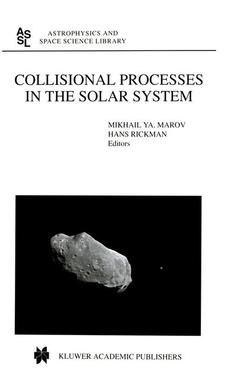Description
Collisional Processes in the Solar System, Softcover reprint of the original 1st ed. 2001
Astrophysics and Space Science Library Series, Vol. 261
Coordinators: Marov Mikhail Ya., Rickman Hans
Language: English
Subjects for Collisional Processes in the Solar System:
Collisional Processes in the Solar System
Publication date: 08-2014
357 p. · 16x24 cm · Paperback
Publication date: 08-2014
357 p. · 16x24 cm · Paperback
Collisional processes in the solar system
Publication date: 04-2011
368 p. · 23.4x15.6 cm · Paperback
Publication date: 04-2011
368 p. · 23.4x15.6 cm · Paperback
Description
/li>Contents
/li>
The exploration of our Solar System is rapidly growing in importance as a scientific discipline. During the last decades, great progress has been achieved as the result of space missions to planets and small bodies - as teroids and comets - and improved remote-sensing methods, as well as due to refined techniques of laboratory measurements and a rapid progress in theoretical studies, involving the development of various astrophysical and geophysical models. These models are based, in particular, on the approach of comparative planetology becoming a powerful tool in revealing evolu tionary processes which have been shaping the planets since their origin. Comets and asteroids, being identified as remnants of planetary formation, serve as a clue to the reconstruction of Solar System history because they encapsulated the primordial material from which the planets were built up. At the same time, these interplanetary carriers of original matter and mes sengers from the past, being triggered by dynamical processes well outside our neighboring space, were responsible for numerous catastrophic events when impacting on the planets and thus causing dramatic changes of their natural conditions. In the crossroads of astronomy and geophysics, recent years have seen a growing understanding of the importance of collisional processes through out the history of the Solar System and, therefore, the necessity to get more insight into the problem of interactions of planets and small bodies.
Preface. Size-frequency distributions of planetary impact craters and asteroids; B.A. Ivanov, et al. The meteoroidal influx to the Earth; Z. Ceplecha. The impact record on asteroid surfaces; W.F. Bottke, Jr., R. Greenberg. Cometary Dynamics; H.F. Levison, M.J. Duncan. Variable Oort cloud flux due to the Galactic tide; J.J. Matese, et al. Galactic triggering of periodic comet showers and mass extinctions on Earth; M.R. Rampino. The role of non-gravitational forces in decoupling orbits from Jupiter; D.J. Asher, et al. The cometary contribution to planetary impact craters; H. Rickman, et al. Physical properties of planet crossing objects; D. Jewitt, Y. Fernandez. Distant comet observations; K.J. Meech, O.R. Hainaut. Long-term orbital evolution of protoplanets; K. Yoshinaga, et al. Accretional origin of the giant planets and its consequences; W.-H. Ip, J.A. Fernandez. N-body simulations of Moon accretion; S. Ida, et al. Volatile inventory and early evolution of the planetary atmospheres; M.Y. Marov, S.I. Ipatov. From the interstellar medium to planetary atmospheres via comets; T.C. Owen, A. Bar-Nun. Dust influx to Titan from Hyperion; A.V. Krivov, M. Banaszkiewicz. Collisional effects in the Edgeworth-Kuiper belt; D.R. Davis, P.F. Farinella. In Memoriam: Paolo Farinella; D.R. Davis. Origin and evolution of near Earth asteroids; A. Morbidelli. Formation of asteroid families and delivery of NEO showers from the main belt; V. Zappala, A. Cellino. Near-Earth asteroid surveys; A.W. Harris. NEO, the Spaceguard system and the Spaceguard Foundation; A. Carusi. Index.
© 2024 LAVOISIER S.A.S.
These books may interest you

Exploring the PlanetsA Memoir 50.94 €

A History of the Solar System 27.60 €


